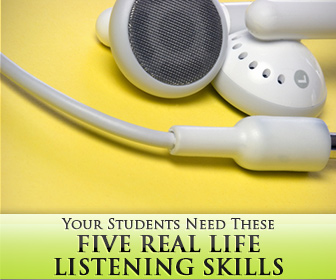Listening is something we do every day.
Whether in a first language or a second language, people are constantly hearing and processing language. But what exactly do we do when we process language? And what do we need to teach our ESL students to do? These five real life listening skills are the keys your students need to understand what they hear every day.

5 Lifesaving Listening Skills for Your Students
-
1
They need to determine what they are hearing
Are they listening to a lecture? Are they part of a negotiation? Are they the recipient of small talk? Before they can make sense of what they are hearing, your students will need to determine what they are hearing. It’s because the reason someone is speaking affects what their listeners will need to do with it. In other words, the type of speech determines what listening skills they will need to engage. Different listening skills are necessary for having a conversation than for listening to a lecture or watching a television program.
-
2
They need to understand what they are hearing
Encourage your students to focus on phrases, patterns of speech, and ideas.Once your students know why they are listening to someone, they need to understand what they are hearing. But that doesn’t mean they need to process every word the speaker sends their way. Trying to understand and remember every word in sequence is more than the short term memory can handle. When students understand and remember chunks of language or ideas, their comprehension increases. Encourage your students to focus on phrases, patterns of speech, and ideas. They should avoid mentally translating every word they hear into their native language but should try to understand the ideas instead of the words. This listening strategy affects the ESL teacher, too. So when you assess your students, don’t ask about specific words or quotations. Instead ask about units of meaning, ideas and how they relate to each other.
-
3
They need to guess what is coming next
Your students have determined what type of speech they are hearing and decided what its purpose is. They are listening and understanding and processing the information as it comes in chunks of words or ideas. But listening is more than just taking in what you hear. As they are listening, it is important that your students predict what information will be coming next. When they do make mental predictions, they will be better able to understand and process the language that is to come. Think of it this way. If you knew you were having a piece of furniture delivered, you would make a space for it to go. You wouldn’t wait until the couch was at the front door before determining where it should go and what you have to move to put it there. Language is like that. When a listener has an idea of what is coming, he or she can have a mental place ready for the information as it arrives from the speaker.
-
4
They need to remember what they already know about the subject at hand
Learning is about making connections. Every learner will understand and retain information better when they link it to something they already know. Think of the mind as an ever increasing collection of Lego blocks. The new blocks are easier to hold on to when they snap into one of the blocks already there. The sooner your students can remember what they know about a given subject, the better their comprehension and retention will be with the new information they are given. Helping your students remember what they already know before or during listening practice will make their listening exercise more productive. If you can, get your students thinking about today’s subject before the listening exercise with discussion questions or a K/W/L chart. In real life, though, your students will not always get a heads up on a conversational topic. That means as they are listening they should also be thinking about what they already know.
-
5
They need to decide what the speaker means
Understanding words and ideas are essential to determining meaning, but they are not the only important pieces of that puzzle. Sometimes meaning goes deeper than the words that are said. Sometimes a speaker’s meaning is implied, that is, the speaker means something deeper than the words on the surface. For example, someone might say, “Is it hot in here?” The speaker could just want an answer to his question, but if you are sitting next to the window, he might mean for you to open the window. Your students need to be able to determine the intended meaning of the speakers with whom they speak. Sometimes the meaning is literal, your students can take their words at face value. But they also have to be prepared to decipher an intended meaning beyond the surface of the words they hear and understand.
Once you and your students understand these five essential skills for real life listening, you will begin to see that listening is not a passive activity. Listening is an activity that includes comprehension, prediction, recall and analysis. Luckily, with a little practice, your students can become experts at every step.
How do you help your students practice active listening?
P.S. If you enjoyed this article, please help spread it by clicking one of those sharing buttons below. And if you are interested in more, you should follow our Facebook page where we share more about creative, non-boring ways to teach English.







